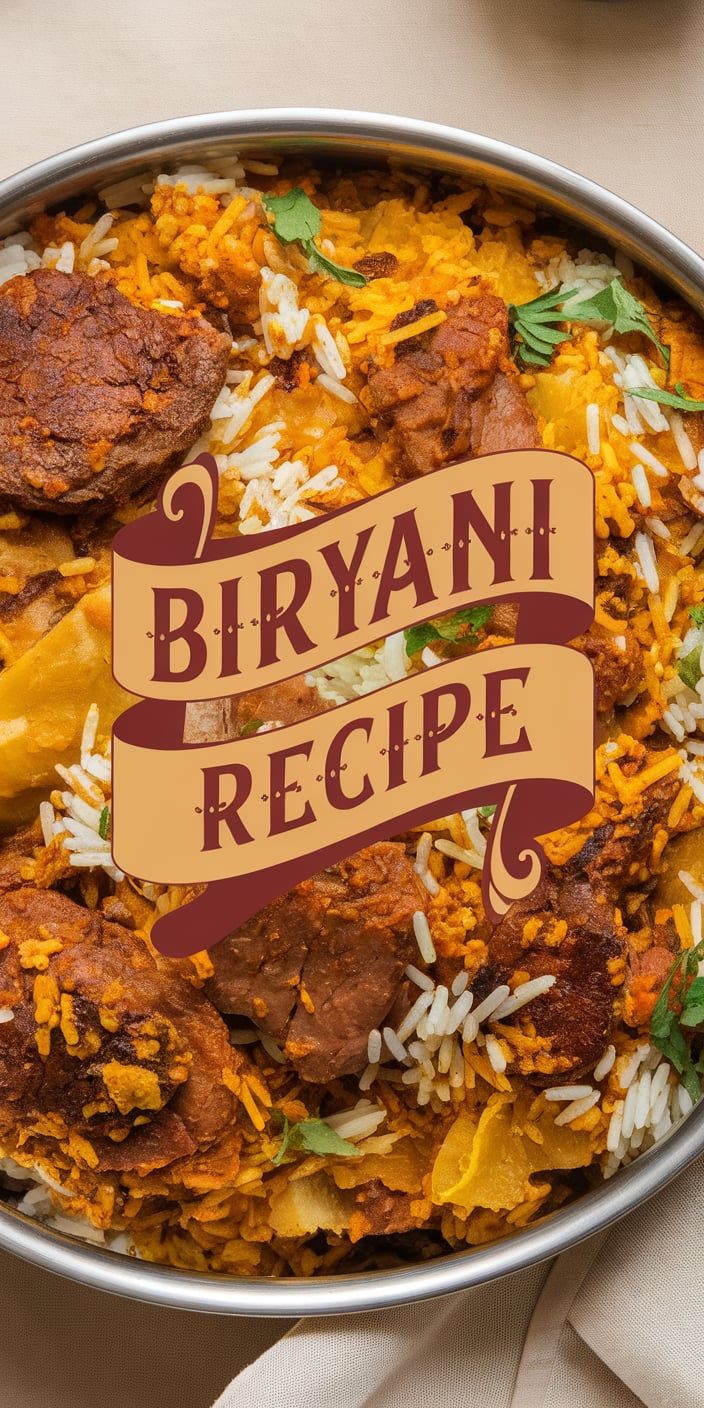Welcome to the ultimate guide for creating an authentic biryani recipe that will transport your taste buds straight to the heart of India! As a passionate home cook, I’ve spent years perfecting this incredible Indian rice dish that combines rich flavors, aromatic spices, and generations of culinary tradition.
Biryani isn’t just a meal – it’s a celebration of taste and culture. This legendary dish represents the pinnacle of Indian cuisine, blending complex spices with tender meat and perfectly cooked rice. Whether you’re a cooking novice or an experienced chef, my step-by-step guide will help you create a mouthwatering authentic biryani that will impress family and friends.
The beauty of biryani lies in its versatility. Each region of India offers its own unique twist, making this dish a true culinary adventure. From the fragrant Hyderabadi style to the subtle flavors of Lucknow, you’ll discover why biryani remains a beloved staple in South Asian cuisine.
Get ready to embark on a delicious journey that will transform your kitchen into a spice-filled paradise. Let’s dive into the world of biryani and unlock the secrets of this incredible rice dish!

What Makes Biryani So Special and Its Rich Heritage
Biryani stands as a culinary masterpiece that reflects the vibrant tapestry of Indian cuisine history. This beloved dish transcends mere food, representing a cultural journey that has captivated taste buds for centuries. My exploration of biryani’s heritage reveals a fascinating narrative of flavors, traditions, and regional creativity.
The roots of biryani can be traced back to the Mughal era, where royal kitchens transformed cooking into an art form. Biryani heritage is deeply intertwined with cultural exchanges and culinary innovations that spread across South Asia.
Origins in Indian Culinary Landscape
Biryani’s journey began with Persian influences, brought by travelers and rulers who introduced complex cooking techniques. The dish evolved through multiple cultural interactions, becoming a quintessential representation of regional diversity.
- Persian migrants introduced layered rice cooking techniques
- Mughal emperors refined the recipe in their royal kitchens
- Local ingredients transformed the original recipe
Regional Variations Across South Asia
Regional biryani variations showcase the incredible diversity of Indian cuisine. Each region adds its unique twist, creating a culinary map that reflects local ingredients and cooking styles.
| Region | Biryani Characteristic |
|---|---|
| Hyderabad | Dum-style cooking, rich spices |
| Kolkata | Potato-infused, lighter spices |
| Lucknow | Subtle flavors, refined technique |
Celebration of Culinary Tradition
Biryani remains a celebration favorite because it represents more than a meal—it’s a cultural experience. Its ability to bring people together, create memories, and showcase culinary artistry makes it an enduring symbol of hospitality and joy.
Essential Ingredients for the Perfect Biryani Recipe
Creating an authentic biryani requires carefully selected ingredients that work together to develop rich, complex flavors. Each component plays a crucial role in transforming simple ingredients into a spectacular dish that delights the senses.
Selecting the Right Rice Type
Basmati rice stands as the gold standard for biryani ingredients. This long-grain rice brings an exceptional fragrance and delicate texture that elevates the entire dish. When choosing basmati rice, look for aged varieties that offer superior aroma and separated grains after cooking.
- Long-grain basmati rice
- Aged rice preferred for better flavor
- White or slightly golden colored grains
Key Spices and Aromatics
Biryani spices are the heart and soul of this beloved recipe. A perfect blend creates layers of depth and complexity that make each bite memorable.
| Spice | Purpose |
|---|---|
| Cardamom | Adds sweet, aromatic notes |
| Cinnamon | Provides warm undertones |
| Saffron | Delivers luxurious color and flavor |
| Cumin | Brings earthy warmth |
Meat and Protein Options
Exploring biryani meat options allows for incredible culinary creativity. Traditional recipes often feature chicken, lamb, or goat, but modern interpretations welcome diverse protein choices.
- Chicken (most popular)
- Lamb
- Goat
- Vegetarian alternatives like paneer or mixed vegetables
Equipment and Preparation Tips Before Cooking
Preparing a delicious biryani requires the right biryani cooking equipment and careful preparation. I’ll walk you through the essential tools and preparation tips that will help you create an authentic and flavorful dish.
Essential Cooking Equipment
Selecting the right biryani cooking equipment is crucial for achieving the perfect result. Here are the key tools you’ll need:
- Heavy-bottomed pot or traditional handi (clay pot)
- Sharp chef’s knife
- Cutting board
- Large mixing bowls
- Measuring cups and spoons
- Wooden spoon or spatula
Preparation Tips for Smooth Cooking
My top biryani preparation tips will help you streamline the cooking process and ensure success:
- Gather all ingredients before starting
- Wash and soak rice for 30 minutes
- Chop vegetables and measure spices in advance
- Prepare marinade at least 2 hours before cooking
| Equipment | Purpose | Recommended Type |
|---|---|---|
| Handi | Even heat distribution | Clay or thick-bottomed copper pot |
| Knife | Ingredient preparation | 8-inch chef’s knife |
| Mixing Bowl | Marinating and mixing | Large stainless steel bowl |
By investing in quality biryani cooking equipment and following these preparation tips, you’ll set yourself up for a culinary success that will impress your guests and satisfy your taste buds.
Marinating and Preparing the Meat Layer
Crafting the perfect biryani starts with mastering the art of meat preparation and marination. The right biryani marinade can transform ordinary meat into a spectacular culinary experience that brings layers of flavor to your dish.
Creating the Perfect Marinade
A successful meat preparation for biryani begins with a robust marinade that tenderizes and infuses deep flavors. I recommend a blend of key ingredients that elevate the meat’s taste profile:
- Yogurt (acts as a tenderizing agent)
- Ginger-garlic paste
- Fresh mint and cilantro
- Kashmiri red chili powder
- Garam masala
Optimal Marination Techniques
When exploring marination techniques for biryani, timing is crucial. Different meats require varied marination periods to achieve maximum flavor absorption:
| Meat Type | Marination Time | Recommended Method |
|---|---|---|
| Chicken | 2-4 hours | Refrigerated, covered |
| Lamb | 4-6 hours | Overnight marination preferred |
| Goat | 6-8 hours | Slow marination for tenderness |
Pre-cooking Methods for Different Meats
Pre-cooking meat ensures it remains tender and flavorful in the final biryani dish. I suggest light searing or partial cooking before the final layering process. This technique helps lock in moisture and intensify the meat’s natural flavors.
Rice Preparation and Layering Techniques
Mastering biryani rice preparation is an art that transforms a simple dish into a culinary masterpiece. The key to exceptional biryani lies in perfectly cooked rice and strategic layering techniques that maximize flavor and texture.
I’ll share my tried-and-true method for preparing basmati rice that ensures each grain is fluffy and fragrant. Start by selecting long-grain basmati rice, which is essential for authentic biryani layering techniques.
- Rinse rice thoroughly to remove excess starch
- Soak rice for 30 minutes before cooking
- Use a 1:1.5 rice to water ratio
- Par-cook rice until 70% done
The secret to perfect biryani rice preparation involves partial cooking. I recommend cooking the rice until it’s about three-quarters done, which allows it to finish cooking during the final steam process.
| Rice Type | Soaking Time | Cooking Method |
|---|---|---|
| Basmati Long Grain | 30 minutes | Par-boiled with whole spices |
| Sella Basmati | 20 minutes | Parboiled with light seasoning |
Biryani layering techniques are crucial for creating depth of flavor. I always start with a base layer of partially cooked rice, followed by a layer of marinated meat, then repeat the process. This method ensures each bite is infused with rich, complex flavors.
My final tip: use a heavy-bottomed pot and seal the lid with dough to trap steam, allowing the rice and meat to cook together perfectly. This traditional method, known as dum cooking, elevates the entire biryani experience.
Step-by-Step Cooking Method and Assembly
Crafting the perfect biryani requires precision and patience. The biryani cooking method is an art that transforms simple ingredients into a spectacular dish. I’ll guide you through the intricate process of creating a mouth-watering biryani that will impress your family and friends.
Creating the First Layer
The foundation of an exceptional biryani lies in its first layer. I recommend starting with a base of caramelized onions and aromatic spices. This initial layer sets the tone for the entire dish, infusing rich flavors throughout the biryani assembly.
- Thinly slice 2 large onions
- Fry until golden brown and crispy
- Spread evenly at the bottom of a heavy-bottomed pot
Proper Layering Sequence
Layering is crucial in the dum cooking process. I’ll share the perfect sequence to ensure maximum flavor distribution:
- Caramelized onion base
- Marinated meat layer
- Partially cooked fragrant rice
- Fresh herbs and additional spices
Dum Cooking Process
The traditional dum cooking method is what truly elevates biryani to a culinary masterpiece. I seal the pot with a tight-fitting lid and cook on low heat, allowing the flavors to meld perfectly.
| Cooking Stage | Temperature | Duration |
|---|---|---|
| Initial Sealing | High Heat | 5 minutes |
| Dum Cooking | Low Heat | 25-30 minutes |
| Resting Period | No Heat | 10 minutes |
Pro tip: Use a heavy lid or seal with wheat dough to trap steam and ensure the most authentic dum cooking experience. The result will be a biryani with layers of flavor that will transport you straight to the heart of traditional Indian cuisine.
Serving Suggestions and Traditional Accompaniments
When serving biryani, I recommend pairing it with classic biryani side dishes that enhance the overall dining experience. A cool and creamy raita is essential among traditional biryani accompaniments. I love preparing a simple cucumber raita with yogurt, fresh mint, and a pinch of roasted cumin powder to balance the rich spices in the main dish.
My favorite biryani serving suggestions always include mirchi ka salan, a spicy green chili curry that complements the layered rice perfectly. For protein lovers, a boiled egg garnished with chaat masala adds an extra layer of flavor. These accompaniments not only provide textural contrast but also help cut through the biryani’s intense spice profile.
Presentation matters when serving this royal dish. I recommend using a wide, shallow serving platter that allows the beautiful layers to be visible. Garnish with fresh cilantro, mint leaves, and some caramelized onions on top. A small side of lime wedges lets guests adjust the tanginess to their preference, making each bite of biryani a personalized culinary experience.
To complete the meal, serve with chilled beverages like lassi or buttermilk. These traditional biryani side dishes transform a simple meal into a memorable feast that celebrates the rich culinary heritage of South Asian cuisine.
